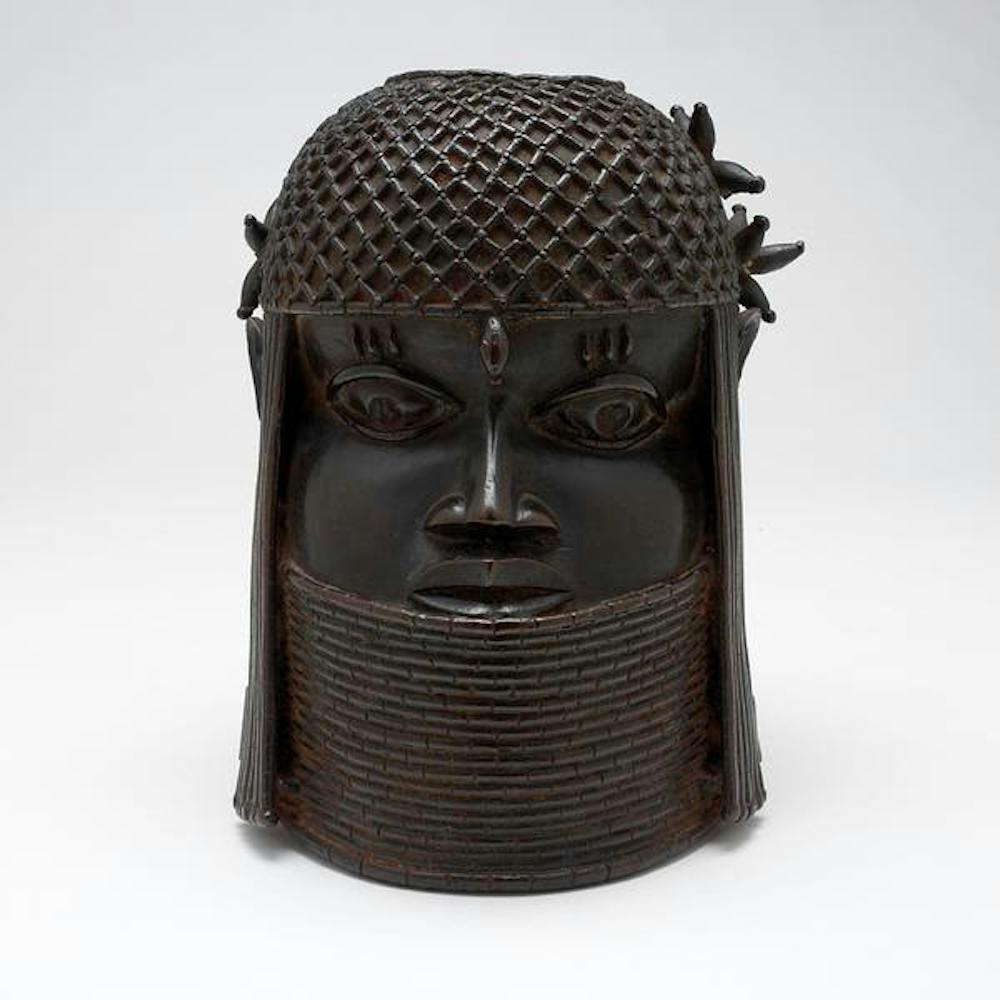The Rhode Island School of Design Museum returned a Nigerian bronze sculpture, “Head of a King (Oba),” to the Nigerian National Collections Oct. 11. The sculpture had been held by the museum since 1939 and was one of 31 looted artifacts, also called Benin Bronzes, repatriated to Nigeria by American institutions earlier this month, according to a RISD Museum press release.
The exchange, which took place at the Smithsonian Institution in Washington, D.C., also included 29 objects from the Smithsonian and one from the National Gallery of Art.
“After four years of working with community partners in Nigeria and the United States, as well as the Benin Dialogue Group, the RISD Museum is pleased to have reached this milestone,” the press release reads.
The Benin Bronzes were looted in 1897 when British troops raided the Royal Palace of Benin, Gina Borromeo, chief curator and curator of ancient art at the RISD Museum, said at an event marking the repatriation with Jan Howard, curator of prints, drawings and photographs at the RISD Museum. Of the objects that were looted, 40% were taken into the collection of the British Museum in London, Borromeo added.
“Head of a King (Oba)” was given to the RISD Museum by Lucy Truman Aldrich in 1939 after it was purchased from the Knoedler Gallery in New York, according to the press release. It may have previously been in a French collection.
Royal objects such as those looted from Nigeria “were often collected and prized” throughout Europe, RISD Museum Interim Director Sarah Ganz Blythe told The Herald.
Ganz Blythe said objects like the Benin Bronze were acquired “through acts of incredible violence,” which makes it “untenable” to continue owning them. RISD deaccessioned “Head of a King (Oba)” from its collection in 2020 after a unanimous decision by the board, according to the press release.
To deaccession an artifact from a collection, the museum staff must first propose it to the museum’s governing body, Ganz Blythe said. Then, governing bodies with fiduciary responsibilities of the museum must hold a vote to “disown the object.” In the past, the RISD Museum has deaccessioned decaying artifacts and pieces that did not fit with the rest of its collection, Ganz Blythe added.
The process of returning the sculpture was “fairly intricate,” Ganz Blythe said. The museum needed to be “responsive to the culture of origin” and its timelines and desires, she explained.
Museums have historically been “complicit in colonialism and colonial plunder,” said Daniel Smith, director of Brown’s Africa Initiative and professor of anthropology and international studies. The idea that “those nationalities and the museums in which (these artifacts) reside are somehow superior venues for other people’s cultural materials” is “problematic,” he added.
The problem is compounded when museums disregard the context of “expropriated” artifacts, Smith said. Museums can exhibit other cultures’ art and artifacts with creative license, he explained, but “it has to be in collaboration … with the people” in the places from which the artifacts originated.
“‘Creative’ doesn't mean you have license to erase the meaning of (the artifact) and the place that it was taken from or the histories that led to its appearance” in the museum, he said.
The “looting” of such artifacts leads to a continuous “destruction of heritage,” said Peter Van Dommelen, director of the Joukowsky Institute for Archaeology and the Ancient World and professor of anthropology and archaeology. “We have just a single isolated object” devoid of the context, so the complexities can be “forever lost” even if the artifact is returned later, he said.
Van Dommelen, who specializes in the rural and Indigenous Mediterranean past and present, said the practice of colonial plunder “could go back to antiquity itself.”
“But the scale at which this is happening has changed” since the onset of European colonialism, he said, partly because of “the constant demand by markets for these objects.”
Museums that display artifacts stolen by European colonizers also risk portraying them with a specific narrative, Van Dommelen said. Other artifacts would never have been put on display in their country of origin, he added.
Smith suggested that cultural interpretations of “Head of a King (Oba)” have likely changed since the sculpture was created. “There's a lot of complexity that should be represented in the way that the materials are contextualized” by providing thorough details on placards, he added.
“Head of a King (Oba)” was “imbued with spiritual energy that guides individuals throughout their lifetimes and determines a person’s destiny,” Borromeo said at the event, referencing the sculpture’s original context. “Oba” refers to the ruler of certain peoples in the Benin region of West Africa.
“One of the first tasks of an incoming oba was actually to commission an idealized head of his predecessor from bronze casters who worked for the royal court,” Borromeo explained. “This head that was commissioned served to honor and usher the deceased oba into the pantheon of ancestor kings. It also provided a way for the ruling oba to access the wisdom of past obas,” she added.
Ganz Blythe said that the return is one step the RISD Museum is taking to decolonize its collection.
“It’s very easy for institutions to say we’re anti-racist or decolonizing our collection,” she said. But for the RISD Museum, repatriating “Head of a King (Oba)” is a concrete action that works “against the energies and violence of colonialism.”
“There’s no master plan of how to unwind centuries of colonialism,” so the RISD Museum approaches the process “object by object,” Ganz Blythe added.
After deaccessioning “Head of a King (Oba),” the RISD Museum continued to display it for museum visitors. Learning about colonial history occurs through “textbooks, literature and primary sources,” and an artifact is “yet another primary source,” Ganz Blythe said.
“Being an educational institution,” the RISD Museum thought it was really important “to be transparent about the process” so that “the public could be aware of how these things come into the collection through violence,” she added.
The repatriation “opens a new vista regarding the U.S.A.’s cultural institutions’ relationship with Nigeria,” said Abba Isa Tijani, director-general of Nigeria’s National Commission for Museums and Monuments, in the press release. The repatriation is also “a harbinger of greater things to come, as other museums and institutions here in the U.S. with collections of Benin Bronzes are expected to follow suit.”
Despite increased awareness of the importance of repatriation of stolen artifacts, Smith believes that“we’re only at the beginning in many ways.”





